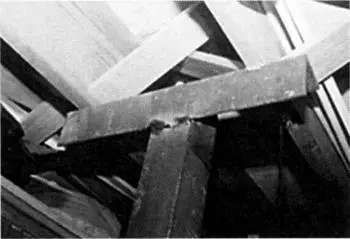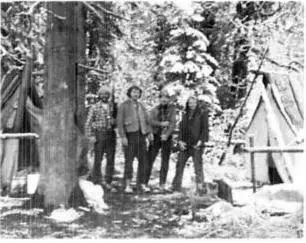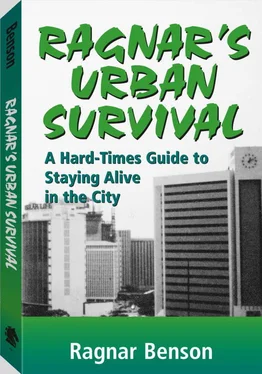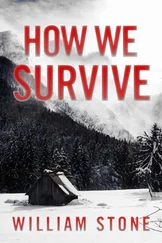The simplest of these involves placing a sign on the door which might read, “custodial storage area,” or, “danger, high-voltage power boxes, no unauthorized entry.” Another, displaying the universal sign for radiation danger, is a proven winner. In our culture, signs warning of chemical danger or of fumigation danger are extremely effective. At present, signs warning of asbestos also produce great alarm.
In cities it is often easier than that. Rather than official-looking, nicely printed color signs, survivors can easily post hastily made signs warning of chemical danger and poison gas ahead, or that an area is known to contain antipersonnel and antivehicle mines and has not been properly cleared of such. I would even post a warning about snipers working in teams on the area ahead, and that military personnel should understand that the area has not been secured. Warnings of unexploded artillery or mortar rounds or bombs may also be effective.
Will it come to this in the United States? In some cases signs must be written in languages other than English! Warning symbols for chemical or biological weapons or mines, which are universally used without script in any language, may be effective. Will this stuff work? Reports indicate that it often does. I would follow expert recommendation and give these ploys a try.
People, especially in our culture, greatly fear the unknown. Americans are currently irrationally fearful of chemicals and radiation. Soldiers are trained to ignore their fears. But, who knows—you may be lucky and encounter lazy, fearful soldiers.
Other problems may be as pervasive. Slipping in and out for additional supplies of food, water, medicine, and fuel is one that comes to mind. Can rabbits and pigeons be kept close at hand in places convenient to the retreat? Perhaps they can’t be kept right in the apartment building, gut they can be put in areas accessible to those retreating in the apartment complex.
Like positioning a new McDonald’s hamburger joint, three things are vital: location, location, and location. Not only should one’s apartment retreat be in a nondescript, nontargeted neighborhood, but it should be in a location where survivors can slip in and out easily. Sometimes this takes creative remodeling! In Beirut, many apartment dwellers punched an additional way out through the wall to a stairwell or to an external fire escape. In one case it was a hole in the ceiling, eventually leading to a hallway out.
We all have heard that the best place to hide a tree is in a forest. For city survivors, this becomes something of a golden rule. There are an incredible number of potential survival shelter locations in built-up areas. Most experienced people say it is relatively easy to find something that will work. When fighting has been especially heavy, driving most citizens out of an area, it is especially easy.
Walk-ups on the fourth floor and above provide great protection so long as the building is not a targeted, defended, or a dominant building in the area. Both attacking and defending forces will frequently attempt to turn a dominant building into a fire or observation center. Don’t pick a building likely to become the home of a mortar position or a roe et crew.
High-rise buildings “rubbleized” on the top few floors are excellent retreat locations. Rubble above provides a sort of protective cap. On the street below, chunks of cement, rock, glass, and pieces of jagged steel lying about give an impression of desolation, and may impede some traffic.

Floors beneath rubbleized portions of buildings can be braced to afford camouflage and protection.
Here is a really disgusting suggestion that may provide helpful in some circumstances. When a long-dead, foul-smelling horse, cow, dog, goat, camel, or whatever can be found, pull it into the retreat area. The smell of death may nauseate defenders, but it also deters those with just a curious motive from staying and looking around.

A good supply of plastic tarp and rope is useful to construct temporary shelters.
In some cases in Beirut, survivors reinforced top floors of buildings with steel girders and heavy wooden beams. They then intentionally rubbleized the top few floors, both adding protection and giving the impression that the building was vacant and destroyed.
Madrid and Berlin were too early for this technology, but it is amazing how quickly city survivors string up standard blue, green, or brown plastic tarps around the area. Not only are these tarps used to collect drinking water, they close holes in roofs and sides of buildings to keep weather and sun out. They also preclude observation of those inside. After a few days, the presence of one more tarp shelter creates little additional alarm.

Needles and thread are essential items which are often overlooked.

City survivors appreciate tents because of the flexibility.
Here are some suggestions for those who intend to use plastic tarps as one of their shelter strategies. Don’t plan to use overly large tarps, urges our been there, done that crew. These are too difficult to manage and often impossible to obscure, much less hide. A 12-x-20 footer is about right for urban survivors, they claim.
Plan for a large quantity of tough, durable nylon rope, they suggest. No doubt turning these tarps into a kind of improvised shelter is much handier with ample rope. In wild, tough climates, shelters won’t survive the first storm unless they are thoroughly anchored.
It is also very important to lay in several large sail needles and ample thread to make emergency repairs. Without means of repair, a torn tarp or one with a hole poked through it or a pulled grommet must be discarded. With needle and thread, repairs are made and life in the shelter goes on, such as it is.
Many city survivors, especially in colder climates, reckon that they could have used small, insulated, highly portable tents. Staying out of harm’s way in a city is an incredible challenge. No question that using small two- and three-man tents to move quickly and often would be very helpful. Essentially, they recommend that city survivors camp in various locations in and out of buildings in their city.
Placing an additional tent or two in one’s emergency gear is not particularly difficult. But, like knowing about needles and thread for repairs, tents are not items city survivors normally think about.

Many survivors use common, inexpensive fiberglass septic tanks as underground retreats or as containers for potable water.
One survivor purchased an old steel 2,000-gallon underground oil tank. It was surplus from an environmentally incorrect service station. It sat for so long in a wrecking yard that the tank no longer smelled of oil. He got it and delivery for $100 cash.
Using a Saws-All, he cut a door in one end of the approximately 5-x-12-foot tank. He welded two hinges and a door latch on the steel cutout, providing access and a closing mechanism.
Читать дальше
















